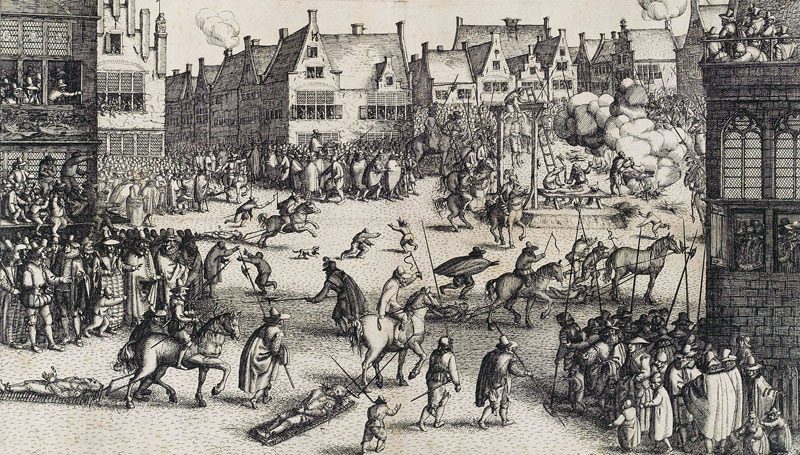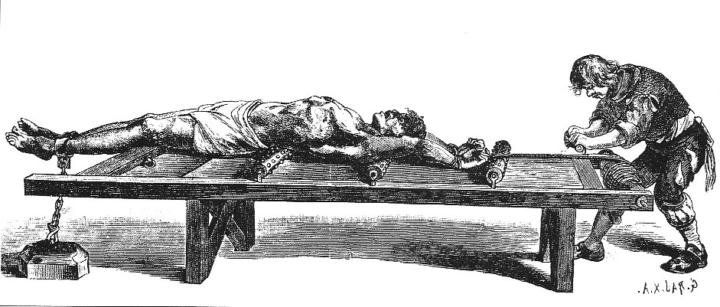Back in the good old days if you did something wrong, for example stole a goat or impersonated a chicken, you were pretty much assured being handed a death sentence. In those days there was no hanging around on Death Row, contemplating the errors of your ways whilst waiting for some form of humane, painless death. Oh no, you might just have been unlucky enough to have sampled one of a plethora of the most unimaginably horrific forms of execution carried out throughout the world. These were almost as idiosyncratic as a country’s national dish and most were almost as unpleasant.
With punishments this bad it didn’t pay to be a criminal in the Dark Ages. I suppose that’s why they made up stuff like witchcraft so the bloodthirsty bastards had someone to put to death.
The forms of execution listed below really are so barbaric that you might question your faith in human nature. You really would have to be an utter sadist to come up with them.
10. Blowing from gun
With the invention of the cannon came this wonderfully imaginative way of executing enemy combatants. The basic method was to tie the unfortunate victim to the barrel of a cannon and fire it. Horrific as this sounds I imagine it was pretty quick. It also sounds like cleaning up wasn’t too bad as most of the body was obliterated. Here is a description from the time:
“When the gun is fired, his head is seen to go straight up into the air some 40 or fifty feet; the arms fly off right and left, high up in the air, and fall at, perhaps, a hundred yards distance”
It was carried out by many of the European colonial nations from the 16th century but it is the British who took to most enthusiastically. It was used in India during the 1857 rebellion against both mutineers and deserters.
9. Gibbeting
Gibbeting was the act of encasing the victim in a metal cage hung from the arm of a gallow. It was used for two reasons; firstly to display the rotting mutilated bodies of executed criminals to serve as a warning or in other cases as the actual method of execution. The prisoner would die from either thirst, exposure or not being able to scratch an annoying itch somewhere.
It seems that using it as an actual method of putting to death was phased out in Britain in the 1700s. Not sure why, obviously not for humanitarian reasons. It continued to be used for displaying bodies into the 1830s and was apparently very popular as a family day out, although it is believed local residents were less in favour.
It is reported that as late as the 1920s gibbeting was used in that bastion of civilisation, Afghanistan, to execute goat rustlers and the likes.
8. Buried alive
Whilst not the most painful method on the list this one fills me with abject terror. It seems to have been very popular in ancient times with one source reporting 400,000 being buried in one go in 2nd century BC China, and this wasn’t an isolated case.
The Romans were also fond of this method, not only reserving it for their enemies, but famously for any Vestal Virgin who failed to maintain her vow of celibacy. In these cases it was a classic example of ancient justice; if she was innocent the god Vesta would rescue her; if not…
OK, so that was in ancient times. Everyone was a bit barbaric in those days. However, what is truly shocking is examples in modern times with the usual culprits featuring heavily. The Nazis, Khmer Rouge and Maoist Chinese all carried out live burials, but it was the Japanese who really excelled themselves. As part of their string of war crimes committed in the 1937 Nanking Massacre Chinese prisoners were buried alive.
7. Fed to Animals
Another extremely popular method of killing with the ancients was throwing to the animals. The advantages are obvious; no weapons are needed, it’s entertaining and the mess is cleaned up. This form of execution could take many forms and really did encourage some imaginative thinking.
The first method was probably just a pit with some vicious animals in. Dogs, wolves or maybe something a little more exotic such as snakes have been suggested. Of course it is the Romans who took this to the next level and turned it into a spectator sport. Early Christians were the victims of choice and lions the beast of choice. However, more exotic animals such as crocodiles, hyenas and bears were also introduced.
Perhaps the most perverse and disturbing form of animal induced death was scaphism. This basically involves force feeding and covering the victim in honey, then leaving them staked out to be devoured or stung to death by insects.
6. Cooking
Anyone who has burnt their finger in the kitchen will know how much this hurts. Obviously a similar experience set ancient minds racing and asking themselves how can we turn this into an excruciating form of death? Obviously the first method employed was a variation on the kebab with the victim burnt at the stake. The key here was to make sure that the fire wasn’t too big in which case the victims would probably die of painless carbon monoxide poisoning.
A more refined method of cooking was good old fashioned boiling alive. Methods varied and it was possible to either be put in the cauldron as it was heated or alternatively dunked into already boiling water. Not sure which was worse but another alternative was having the executioner dip the victim in and out to maximise the ordeal.
A particularly imaginative version involved heating oil in a shallow container – yes, like an enormous frying pan.
One other play on the cooking them was the “Brazen Bull” devised in ancient Greece. The bull was a hollow bronze statue with a door in the side. Once the condemned was placed inside the bull a fire would be lit underneath effectively roasting them.
5. Hanged, Drawn and Quartered
Another English speciality was the three staged spectacle of hanging, drawing and quartering. This was reserved for the most serious of crimes, high treason, and was considered the very pinnacle of execution in the Middle Ages.
The process began with the prisoner being placed on a wooden frame and dragged through the streets to the place of execution. On arrival they would be placed on the gallows and hung until close to death.
Now comes the nice part. Whilst still alive they would be cut open and disembowelled, often have their private parts cut off and then be beheaded. But that wasn’t the end of it. Now they were quartered, i.e. cut into four pieces which could be put on display as a warning to others.
If you were unlucky you may have got to watch some of your co-conspirators being executed in this manner before it was your turn. In some cases it is reported that the victims lived long enough to see their entrails drawn out and burned.
The last time this sentence was passed was in 1820. In this case the prisoners were hung to death and then beheaded by a surgeon as some sort of f*****d up concession to humanity. Apparently this did not go down with the crowd who by that day and age had lost the mob’s lust for gory executions.
4. Flaying
Now flaying is not your run of the mill method of execution. This sadistic form of killing involving skinning the victim alive was only enacted by the most deranged and bloodthirsty of regimes. One lot that fitted this bill were the ancient Assyrians, allegedly one of the first civilisations. Often reserved for rebel leaders the unfortunate victim would have their skin nailed to the city walls as warning to anyone else with ideas above their station. A particularly pleasant twist was the practice of flaying young children in front of their parents.
Flaying also appears to have been popular with the Aztecs as part of their ritualistic blood lust, although they generally waited until after death.
Skinning seems to have made a bit of a comeback in the 14th century China. One emperor in particular is said to have ordered the flaying of 5,000 women.
3. Torn apart
Being torn limb from limb, or quartering, was another popular method of execution with a long history. It involves the condemned being attached to more than one moveable object which will then depart in opposite directions tearing the person apart in the process. In its classic form this generally involved the person being chained to four horses which then set off in opposite directions. This often didn’t go smoothly and deaths could be agonisingly slow as limbs failed to be ripped off.
There are several interesting plays on this theme. One involves the use of four ships, a method that was apparently popularly used against corsairs on the Barbary coast.
One of the earliest and perhaps most unpleasant was the ancient Roman’s tearing apart by trees. Now you wouldn’t have thought trees were very active or mobile, this form of execution though used younger, more flexible trees. Two trees next to each other would be bent and tied down to the ground with strong ropes. The unfortunate victim would have a leg tied to either tree and then the ropes holding down the tree would be cut. The recoil was said to be sufficient to tear a man apart.
2. Slow slicing
Slow slicing or death by a thousand cuts is a form of torture and execution used in China between 900 AD up until it was banned in 1905. The process known as lingchi involves a knife being used to systematically cut pieces off the condemned person’s body over an extended period. As there was no official handbook of how to cut your victim the process would vary from one executioner to another. If you were lucky, or your crime was not serious then the first cut might be across the throat. However, a truly skillful executioner would keep his victim alive as long as possible.
It is said that the person being executed was often given opium. However, it is unclear whether this was an act of kindness to reduce the pain or a way of making the victim stay conscious for longer.
The executions were always public as part of the intention was to humiliate. With executions continuing as late as 1905 there are photographs of these killings that make for pretty grim viewing.
1. Sawing
The last method of execution on my list is a personal favourite of mine in that it makes me feel slightly more sick that any of the other ones. At the end of the day they are all pretty bad but the idea of the crudely serrated blade and calculated nature of this form of punishment is particularly grim. It is thought that the deviant Roman Emperor Caligula may have been a big fan of sawing.
Whilst there are several forms of sawing, including beheading by saw, the one I am going to focus on is the most unpleasant of all. It is said to have originated in Morocco and is the longitudinal sawing of the body, i.e. from head to groin, or in the worst case visa versa. The whole sawing process was carefully thought out to maximise the horror of the death.
The condemned was suspended upside down for a very specific reason; with the head at the bottom and heart below the cutting, the ensuing massive blood loss would not cause immediate death through loss of blood. I have no idea how far the saw would have got from its initial stroke between the legs and actually thinking about it is making me squirm.
It seems this form of capital punishment was thankfully rare, although for what reason I’m not sure. Given the other gruesome methods above I’m sure it wasn’t out of kindness.












You forgot keelhauling, tying a rope to the hands, and another tied to the ankles. The person was then thrown from the bow of the ship, and the ropes were slow walked down each side of the ship with the body scraping against the barnacle encrusted keel of the ship. In essence the body was slowly sawn in half with all types of fish feeding on you as slowly expire.
Excessively horrifying, especially being… Crushed, sawed, torn, and eaten.
Due to Newton’s third law, it is theoretically impossible to tear somebody into 4 parts simultaneously by using 4 horses. Try it. Get some friends together and make some human-shaped figures out of paper. Spend the rest of your lives trying to get one limb each!